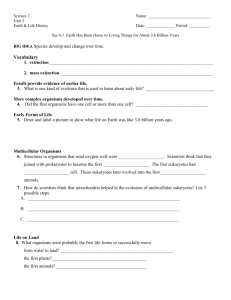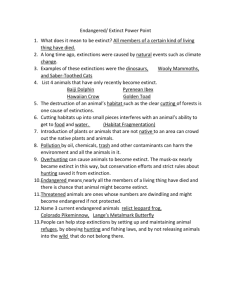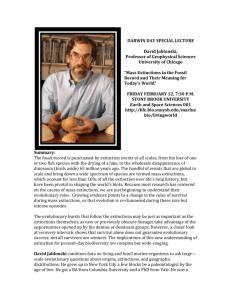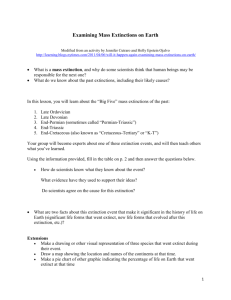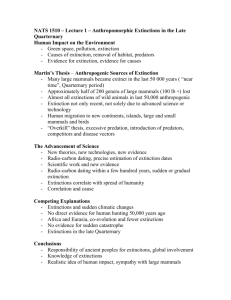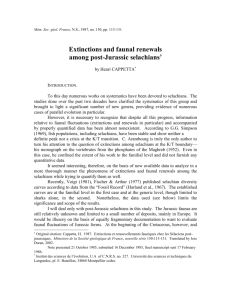Extinction
advertisement
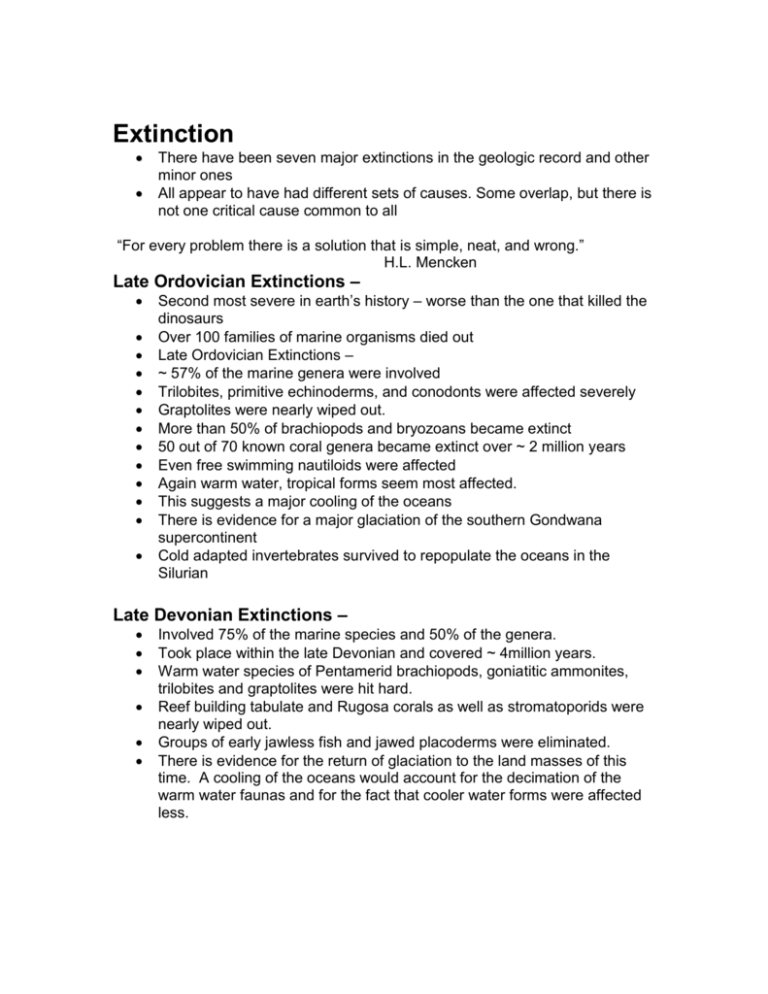
Extinction There have been seven major extinctions in the geologic record and other minor ones All appear to have had different sets of causes. Some overlap, but there is not one critical cause common to all “For every problem there is a solution that is simple, neat, and wrong.” H.L. Mencken Late Ordovician Extinctions – Second most severe in earth’s history – worse than the one that killed the dinosaurs Over 100 families of marine organisms died out Late Ordovician Extinctions – ~ 57% of the marine genera were involved Trilobites, primitive echinoderms, and conodonts were affected severely Graptolites were nearly wiped out. More than 50% of brachiopods and bryozoans became extinct 50 out of 70 known coral genera became extinct over ~ 2 million years Even free swimming nautiloids were affected Again warm water, tropical forms seem most affected. This suggests a major cooling of the oceans There is evidence for a major glaciation of the southern Gondwana supercontinent Cold adapted invertebrates survived to repopulate the oceans in the Silurian Late Devonian Extinctions – Involved 75% of the marine species and 50% of the genera. Took place within the late Devonian and covered ~ 4million years. Warm water species of Pentamerid brachiopods, goniatitic ammonites, trilobites and graptolites were hit hard. Reef building tabulate and Rugosa corals as well as stromatoporids were nearly wiped out. Groups of early jawless fish and jawed placoderms were eliminated. There is evidence for the return of glaciation to the land masses of this time. A cooling of the oceans would account for the decimation of the warm water faunas and for the fact that cooler water forms were affected less. Permo-Triassic Extinctions By far the largest extinction event As much as 96% of the marine species and 75% of land general were affected The “typical” paleozoic marine fauna was gone The following groups became extinct: Trilobites Blastoids Fusulinids Orthid and productid brachiopods All but one family of crinoids All but two genera of ammonoids 75% of land vertebrates This episode of extinction has been the topic of much recent research Evidence shows that this extinction took place in less than 250,000 years. Some data places it between 10,000 and 165,000 years. Evidence points to the fact that this was a time of warming and recession of glaciers that had been in place since the late Carboniferous There was a major sea regression that reduced the shelf area Climates on the Pangea supercontinent were more unstable Oxidation of organic material exposed by the receding seas cut the O 2 content in the atmosphere from ~30% to less than 15%. The erruption of the Siberian traps released a large volume of CO 2 and SO4 into the atmosphere Recent evidence in China of highly siliceous eruptions at the P-T boundary may have put large amounts of ash into the atmosphere as well. Marine and terrestrial extinctions appear to have happened at the same time. Undoubtedly more information on this extinction event will be forthcoming Late Triassic Extinctions Considered the 5th of the “Big Five” 48% of marine genera were eliminated Really a series of extinctions that appear to have occurred over the last two/three stages of the Triassic 90% of bivalve species and 80% of remaining brachiopods became extinct Ammonoids were cut to only a few genera – similar to the end of the Permian Conodonts disappear from the fossil record as do many marine gastropods and crinoids. Ichthyosaurs were the only marine reptile to survive. On land the archaic amphibians, synapsids, and non-dinosaur reptiles were hard hit The Triassic reefs of the Thethys Sea were hard hit and seem to indicate a cooling sea may have been a factor Perhaps meteor impact and the rifting of the North Atlantic contributed to this Cretaceous-Tertiary (K/T) Extinctions Primary cause: meteor impact off current Yucatan Penninsula Also the erruption of the Deccan Traps in India expelled large amounts of CO2 and water vapor at the end of the Cretaceous Couple all this with a massive regression of the sea at the end of the Cretaceous Most agree that some species were in decline prior to these events Dinosaurs became extinct while other reptiles survive – crocodiles,turtles, salamanders Calcareous nannoplankton and rudistid bivalves and the ammonites were decimated. Many land plants were affected One of the most studied, and controversial, extinctions Eocene-Oligocene Extinctions Extended from the mid-Eocene into the Oligocene Global cooling and overturn of the oceans probably initial cause Bivalves, gastropods and warm-water benthic foraminifera were the major groups affected Little effect on terrestrial organisms Most now agree that the changes were directly related to the separation of Antarctica from South America Early Eocene was a very warm “greenhouse” earth, Early Oligocene was one of ice ages. Pleistocene Megafauna extinctions Limited to large land animals Factors? Over hunting by early humans is one idea. Inability to adapt to the last glacial period and accompanying change of vegetation is another. Extinctions happen Are they truly periodic? Is there a common cause?



